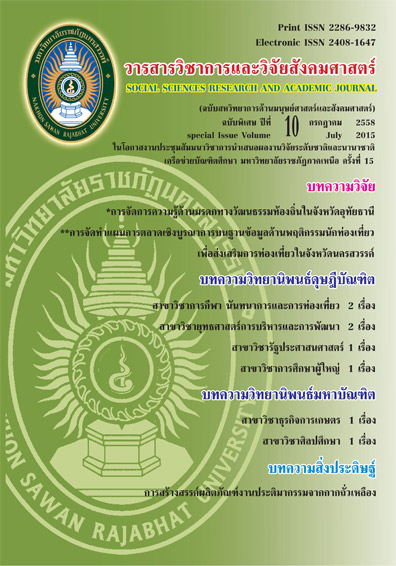การพัฒนากลยุทธ์การจัดทำแผนชุมชนของหมู่บ้านในจังหวัดกำแพงเพชร; The Strategy Development for Community Planning of Villages in KamphaengPhet
Main Article Content
Abstract
บทคัดย่อ
การวิจัยครั้งนี้มีวัตถุประสงค์เพื่อ 1) เพื่อศึกษาสภาพ ปัญหา และปัจจัยที่เกี่ยวข้องกับการจัดทำแผนชุมชนของหมู่บ้านในจังหวัดกำแพงเพชร 2) พัฒนากลยุทธ์การจัดทำแผนชุมชนของหมู่บ้านในจังหวัดกำแพงเพชร 3) ประเมินกลยุทธ์การจัดทำแผนชุมชนของหมู่บ้านในจังหวัดกำแพงเพชร โดยดำเนินการวิจัย 3 ขั้นตอน ได้แก่ 1) การศึกษาสภาพ ปัญหา และปัจจัยที่เกี่ยวข้องกับการจัดทำแผนชุมชนของหมู่บ้านในจังหวัดกำแพงเพชร เทคนิควิธีวิจัยที่ใช้ ได้แก่ การสำรวจความคิดเห็นด้วยแบบสอบถาม จำนวน 1,112 ชุด และการสนทนากลุ่ม ผู้ร่วมจำนวน 17 คน 2) การพัฒนากลยุทธ์การจัดทำแผนชุมชนของหมู่บ้านในจังหวัดกำแพงเพชร โดยศึกษากลยุทธ์หมู่บ้านที่ประสบผลความสำเร็จด้วยการวิเคราะห์เอกสาร การสัมภาษณ์ จำนวน 3 หมู่บ้าน และการประชุมเชิงปฏิบัติการ ครั้งที่ 1 วิเคราะห์ปัจจัยสภาพแวดล้อมให้ผู้เชี่ยวชาญ จำนวน 19 คน และประชุมเชิงปฏิบัติการ ครั้งที่ 2 เพื่อยกร่างกลยุทธ์โดยผู้เชี่ยวชาญ จำนวน 21 คน และสัมมนาอิงผู้เชี่ยวชาญ วิพากษ์ร่างกลยุทธ์ จำนวน 11 คน และ 3) ประเมินกลยุทธ์การจัดทำแผนชุมชนของหมู่บ้านในจังหวัดกำแพงเพชรที่ปรับปรุงแล้ว โดยประเมินความสอดคล้อง ความเหมาะสม ความเป็นไปได้และการยอมรับได้ โดยผู้เชี่ยวชาญ จำนวน 25 คน
ผลการวิจัยพบว่า
1. สภาพการจัดทำแผนชุมชนของหมู่บ้าน คณะกรรมการหมู่บ้านได้ดำเนินการทั้ง 8 ด้าน โดยด้านวิเคราะห์และสังเคราะห์ข้อมูลชุมชนดำเนินการมากที่สุด ส่วนปัญหาที่พบได้แก่ด้านการติดตามประเมินผลและการสรุปบทเรียน อยู่ในระดับมากที่สุด ในด้านปัจจัยภายใน คณะกรรมการหมู่บ้านมี โครงสร้างองค์กรและระบบการบริหารงานที่มีความคล่องตัวสูงและปรับเปลี่ยนได้เหมาะสมตามสถานการณ์และปัจจัยภายนอก ของการจัดแผนชุมชนมีองค์กรปกครองส่วนท้องถิ่นให้การสนับสนุนในการจัดทำแผนชุมชนสอดคล้องกับนโยบายของรัฐบาลแต่บุคลากรขาดความเข้าใจเพื่อวิเคราะห์สภาพปัญหาของปัจจัยที่เกี่ยวข้องกับการจัดทำแผนชุมชนของหมู่บ้านในจังหวัดกำแพงเพชร มีจุดแข็ง 11 ข้อ จุดอ่อน 17 ข้อ โอกาส 8 ข้อ และอุปสรรค 10 ข้อ
2. กลยุทธ์การจัดทำแผนชุมชนของหมู่บ้านในจังหวัดกำแพงเพชรที่สำคัญประกอบไปด้วย 4 พันธกิจ 4 ประเด็นกลยุทธ์ 4 เป้าประสงค์ และจัดทำ 10 กลยุทธ์ 36 ตัวชี้วัด และ 58 มาตรการ
3. ผลการประเมินกลยุทธ์การจัดทำแผนชุมชนของหมู่บ้านในจังหวัดกำแพงเพชร ที่พัฒนาขึ้นในด้านความสอดคล้อง และการยอมรับได้อยู่ในระดับมากที่สุด ในด้านความเหมาะสม และความเป็นไปได้อยู่ในระดับมาก
Abstract
The purposes of this research were 1) to study the status, problems, and factors related to Community planning of villages in KamphangPhet, 2) to develop the strategies for Community planning of villages in KamphangPhet, 3) to evaluate the strategies for Community planning of villages in KamphangPhet. The research procedure was divided into 3 steps as follows, the 1st step was finding the status, problems and factors related about Community planning of villages in KamphangPhet, the research instruments were 1,112 questionnaires, focus group discussions with 17 persons. the 2nd step was developing the strategies for Community planning of villages successful were 3 villages for developing strategies 2 times by 19 and 21 performed persons by connoisseurship 11 persons, and the 3rd was evaluated by 25 connoisseurs. The data were analyzed by using consistency, suitability, feasibility, and acceptable.
The results showed that ;
1. The operation consisted of 8 processes: By the analyzed and synthesized information in the communityhighest level, with the problems were found that aspects evaluation and summarizing were Highest level. The factors associated with the preparation Community planning of the village in KamphaengPhet. The internal factors: Village committee has a corporate structure and systems administration tasks with high mobility and make changes appropriate to the situation andexternal factors of the community has the local government plans to support for the preparation of planned community consistent with government policy, However lack of understanding for analysis of factors associated with Community planning of villages in KamphangPhet, found to have 11 Strengths ,17 Weaknesses, 8 Opportunities and 4 Threats.
2. The Strategies consisted of a vision, 4 missions, 4 goals, 4 strategic issues, 10 strategies, 39 indicators and 58 measures.
3. The results from the strategic evaluation indicated that the developed strategies were accordance, accurate, suitable, and feasible at the highest and at a high level.

